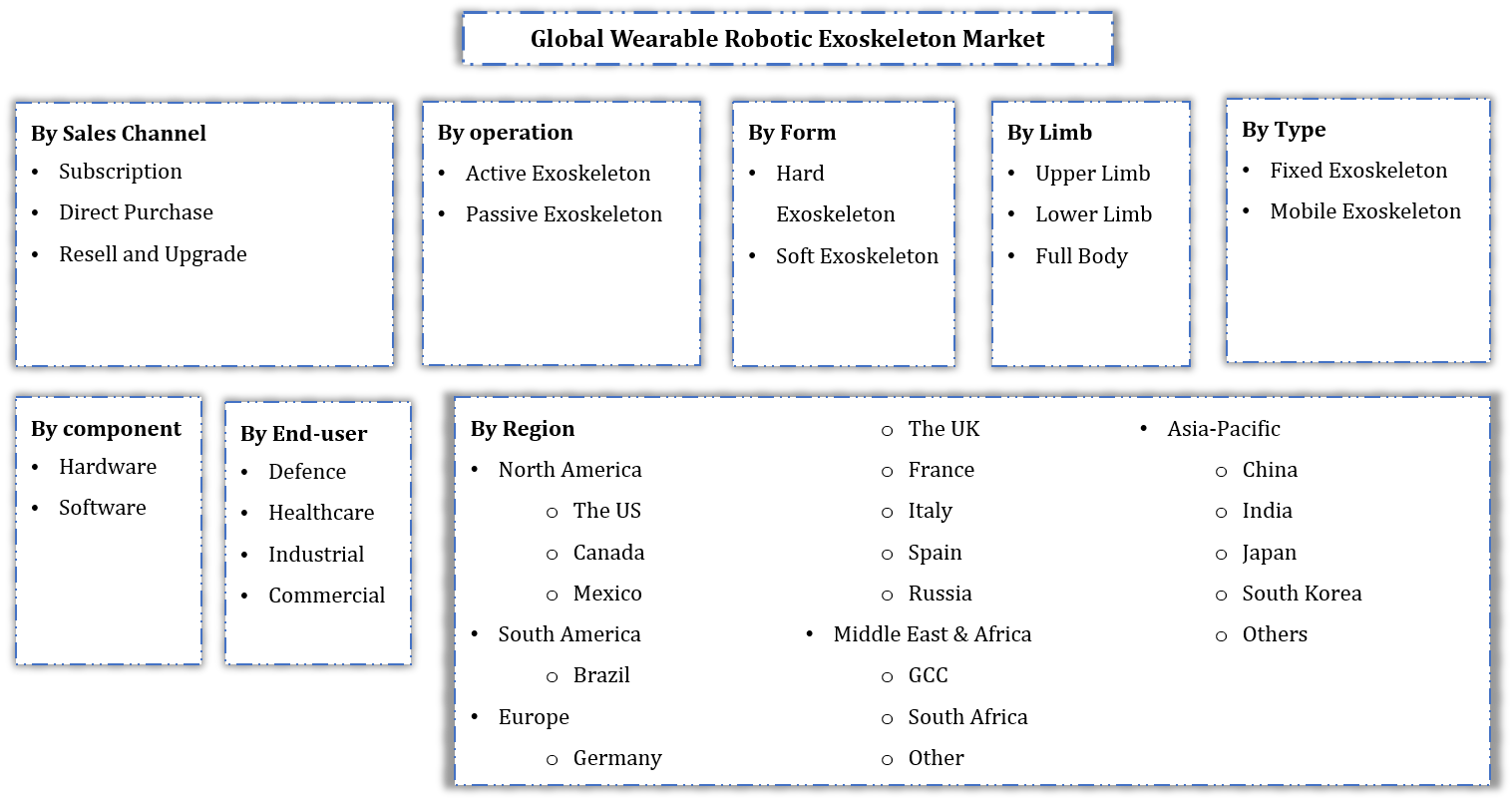
Global Wearable Robotic Exoskeleton Market Research Report: Forecast (2021-2026)
By Type (Fixed Exoskeleton, Mobile Exoskeleton), By Operation (Active Exoskeleton, Passive Exoskeleton), By Form (Hard Exoskeleton, Soft Exoskeleton), By Limb (Upper Limb, Lower L...imb, Full Body), By Sales Channel (Subscription, Direct Purchase, Resell and Upgrade), By Component (Hardware, Software), By End User (Defense, Healthcare, Industrial, Commercial), By Region (North America, South America, Europe, Asia-Pacific, Middle East & Africa), By Country (U.S, Canada, Brazil, Mexico, Germany, France, The U.K, Russia, China, India, Japan, UAE, Israel), By Competitors (ATOUN Inc., B-Temia Inc., Bionik Laboratories Corporation, Cyberdyne Inc., Daiya Industry Co., Ltd., Ekso Bionics, Focal Meditech BV, Hocoma AG, Hyundai Motor Company, Honda Motor Co., Ltd., Lockheed Martin, Mitsubishi Heavy Industries Ltd., Myomo Inc., P&S Mechanics Co. Ltd., Parker Hannifin Corporation, ReWalk Robotics Ltd., Rex Bionics PLC) Read more
- ICT & Electronics
- Feb 2022
- 242
- IT22009
Market Definition
Wearable Robotic Exoskeleton is a technology with high potential to assist humans using sensorimotor impairments to perform daily activities. It is an electromechanical device worn by humans to improve their mobility, strength, and performance while doing any task. It is powered mainly by the combination of electric motors, pneumatics, levers, & hydraulics.
The assistance provided by wearable robotic exoskeletons allows individuals to be physically & socially active and perform activities independently, which further helps enhance their quality of life. It has proven its effectiveness across various industries, including healthcare, by providing patients with strength & mobility to defense by reducing the risk of strain injuries to soldiers. Since wearable robotic exoskeleton technology is attached directly in contact with the body, the system & assistance must be efficient, safe, and usable regularly by the individual.
Market insights
The Global Wearable Robotic Exoskeleton Market is anticipated to grow at a CAGR of around 42% during the forecast period, i.e., 2021-26. The growth of the market is driven primarily by the mounting adoption of wearable robotic technology for military & medical uses, the rapidly growing geriatric population, and surging physical disabilities. Besides, the increasing incidences of Spinal Cord Injuries (SCIs) and the rapid expansion of the healthcare industry with technological advancements shall also drive the global market during 2021-26.
Moreover, the defense sector has experienced ascension in the market growth owing to the thriving demand for wearable robotic exoskeleton across the Asia-Pacific & Europe. These devices are of extreme use across numerous industries and are have promising growth potential over the forecast years. Initially, their demand was driven mainly by the healthcare & military sectors. However, aerospace, automotive, & many more end-users are also contributing to the significantly growing market.
Exoskeleton solutions are being adopted extensively across industries to facilitate employee health & boost their productivity. It has led to numerous startups expertizing in exoskeleton technology & offering rehabilitation-related solutions. Furthermore, the constantly growing exoskeleton industry is encouraging market players to devise innovative product development strategies to escalate the adoption rate in the coming years. For instance:
- In June 2021, suitX launched a novel wearable exoskeleton shieldX, designed for health workers who require wearing heavy anti-radiation aprons and are prone to suffer from neck & back problems.
| Report Coverage | Details |
|---|---|
| Study Period | Historical Data: 2016-19 |
| Base Year: 2020 | |
| Forecast Period: 2021-26 | |
| CAGR (2021-2026) | 42% |
| Regions Covered | North America: USA, Canada, Mexico |
| Europe: Germany, UK, France, Italy, Spain, Russia | |
| Asia-Pacific: China, India, Japan, South Korea, Australia | |
| South America: Brazil, and Argentina | |
| Middle East & Africa: UAE, Saudi Arabia, South Africa | |
| Key Companies Profiled |
ATOUN Inc., B-Temia Inc., Bionik Laboratories Corporation, Cyberdyne Inc., Daiya Industry Co., Ltd., Ekso Bionics, Focal Meditech BV, Hocoma AG, Hyundai Motor Company, Honda Motor Co., Ltd., Lockheed Martin, Mitsubishi Heavy Industries Ltd., Myomo Inc., P&S Mechanics Co. Ltd., Parker Hannifin Corporation, ReWalk Robotics Ltd., Rex Bionics PLC |
| Unit Denominations | USD Million/Billion |
Impact of the Covid-19 on the Global Wearable Robotic Exoskeleton Market
The Covid-19 pandemic in 2020 adversely impacted the global economy due to the imposition of lockdown that led to the temporary shutdown of manufacturing units & other industries. It, in turn, resulted in a sharp decline in the demand for wearable robotic exoskeletons owing to supply chain disruptions & brought robot suppliers to a complete cease. Additionally, reduced capital expenses by companies operating in the market also significantly impacted the market growth.
However, the global pandemic did provide a lucrative growth opportunity to the healthcare sector, which focused on clinical difficulties & adopted advanced technologies. As a result, the demand for wearable robotic exoskeletons witnessed substantial growth in healthcare facilities. Besides, the surge in clinical trials amidst the pandemic and the soaring support by key market participants significantly benefitted the Global Wearable Robotic Exoskeleton Market.
Furthermore, with ease in the restrictions in the shipping, delivery, training, and fulfillment of delayed orders across various regions worldwide, the market is set to revive from financial losses and witness exponential growth in the years to come.

Market Segmentation
By Type:
- Fixed Exoskeleton
- Mobile Exoskeleton
Here, both fixed & mobile exoskeletons have been witnessing substantial growth in different applications. Fixed Exoskeletons acquired a significant market share across industries, such as warehousing, commercial, & construction. On the other front, Mobile Exoskeletons are preferred majorly across military & healthcare sectors, and thus they capture a major market share. These exoskeletons are devices that an individual can wear & work while making movements without any specific premise. With the rapid expansion of healthcare & defense infrastructures, mobile exoskeleton devices have experienced a dramatic boost in their demand. Additionally, the globally booming automobile sector is also increasingly adopting mobile exoskeletons to assist their workers in easing their workload & enhancing productivity.
By Form:
- Hard Exoskeleton
- Soft Exoskeleton
Here, the demand for Soft Exoskeletons is expected to experience the fastest growth during the forecast period. New & innovative materials are being used to manufacture soft exoskeletons to offer more comfort to users. These exoskeletons hold the largest revenue share in the healthcare industry, owing to their mounting adoption among disabled individuals or by those suffering from neurological disorders since they assist them in walking & making movements. Hence, the growing prevalence of people with disabilities has been significantly contributing to the burgeoning demand for soft exoskeletons worldwide.
By End-User:
- Defense
- Healthcare
- Industrial
- Commercial
Of them all, the Healthcare industry holds the largest share in the Global Wearable Robotic Exoskeleton Market, primarily due to the mounting prevalence of Spinal Cord Injuries (SCIs), walking disabilities, & severe backache issues. According to World Health Organization, approximately 250 000 to 500 000 people worldwide suffer SCIs every year. As a result, constant research & development activities are undergoing for providing customized exoskeletons in the healthcare sector. Moreover, increasing awareness of technologically advanced systems and the growing geriatric population is also driving the demand for exoskeleton products in the healthcare industry.
Furthermore, the Industrial sector is projected to experience the fastest market growth in the coming years, primarily due to the surging adoption of these devices across various industries to enhance workforce capabilities. Automotive manufacturers like BMW, Ford, & Honda and electronic manufacturing companies like Samsung, Mitsubishi, & Panasonic are increasingly adopting wearable robotic exoskeletons to improve their business productivity.
Key Trend in the Global Wearable Robotic Exoskeleton Market
- Rapid Integration of Smart Technologies into Robotic Exoskeletons
Robotic exoskeletons are experiencing immense popularity in various industries worldwide to yield enhanced technical capabilities. Moreover, the integration of interactive technologies like the Internet of Things (IoT) & Artificial Intelligence (AI) into these devices is significantly benefiting the logistics, medical, & engineering sectors in terms of both capability & productivity. The need for real-time information of human physiological data, including breathing rate, is another crucial aspect fueling the demand for modifying & optimizing wearable robotic exoskeletons using different technologies.
Regional Landscape:
Geographically, the Global Wearable Robotic Exoskeleton Market expands across:
- North America
- South America
- Europe
- Middle East & Africa
- Asia-Pacific
Globally, of all regions, North America acquires the largest share in the Wearable Robotic Exoskeleton Market. It is due to the significantly high demand for wearable robotic exoskeletons in North America's defense sector since these devices help warfighters run faster & lift heavyweight. Soldiers need highly effective & flexible exoskeletons that are comfortable to wear for long hours owing to the mounting need for increasing their safety & efficiency, which has led the defense sector across North America to invest massively in these technologies. Besides, these devices also support physiotherapy, along with physical stress release. Moreover, the growing emphasis on research & development activities to create efficient products would boost the regional market over the forecast years.
On the other hand, Asia-Pacific is projected to experience the fastest market growth during the forecast period, primarily due to the mounting awareness regarding the various advantages of wearable robotic exoskeletons in the healthcare, manufacturing, defense industries, etc. Across the region, China & Japan are the most prominent developers of exoskeleton wearables since they help prevent workplace injuries while enabling prolonged durations of aging workers in the workforce. Additionally, the increasing production & usage of these devices across Asia-Pacific's defense sector to improve military capabilities shall further contribute to the regional market growth during 2021-26.
Market Dynamics
Key Driver: Mounting Demand for Exoskeleton Devices in the Healthcare Industry
The demand for wearable robotic exoskeletons in the healthcare sector is escalating dramatically due to the snowballing incidences of inborn physical disabilities & road accidents. Moreover, the rising development of lightweight & soft exoskeletons has propelled their demand among the aged population to help them aid their movements. Additionally, mounting cases of strokes & lower-limb disabilities are other crucial aspects projected to fuel the demand for wearable robotic exoskeletons and contribute to the overall growth of the Global Wearable Robotic Exoskeleton Market during 2021-26.
Growth Challenge: Non-coverage of Wearable Robotic Exoskeleton Device by Insurance Companies
Wearable robotic exoskeletons are being used extensively in several applications, like lifting heavy instruments and supporting the movement of elderly or disabled persons. These devices are also experiencing surging demand in military activities since they help warfighters enhance their capabilities on the battlefield. However, the initial investments required for deploying these devices are significantly high. Along with this, these devices are not covered under any medical insurance by any insurance companies. Hence, these factors are the most prominent aspects that might restrain the adoption of wearable robotic exoskeletons on a larger scale in the future.
Competitive Landscape
According to MarkNtel Advisors, the major leading players in the global Wearable Robotic Exoskeleton market are ATOUN Inc., B-Temia Inc., Bionik Laboratories Corporation, Cyberdyne Inc., Daiya Industry Co., Ltd., Ekso Bionics, Focal Meditech BV, Hocoma AG, Hyundai Motor Company, Honda Motor Co., Ltd., Lockheed Martin, Mitsubishi Heavy Industries Ltd., Myomo Inc., P&S Mechanics Co. Ltd., Parker Hannifin Corporation, ReWalk Robotics Ltd., and Rex Bionics PLC.
Key Questions Answered in the Market Research Report:
- What are the overall statistics or estimates (Overview, Size- By Value, Forecast Numbers, Segmentation, Shares) of the Global Wearable Robotic Exoskeleton Market?
- What are the region-wise industry size, growth drivers, and challenges?
- What are the key innovations, opportunities, current & future trends, and regulations in the Global Wearable Robotic Exoskeleton Market?
- Who are the key competitors, their key strengths & weaknesses, and how do they perform in the Global Wearable Robotic Exoskeleton Market based on a competitive benchmarking matrix?
- What are the key results derived from surveys conducted during the Global Wearable Robotic Exoskeleton Market study?
Market Outlook, Segmentation, and Statistics
- Impact of COVID-19 on Global Wearable Robotic Exoskeleton Market
- Market Size & Analysis
- By Value
- By Volume
- Market Share & Analysis
- By Type
- Fixed Exoskeleton
- Mobile Exoskeleton
- By Operation
- Active Exoskeleton
- Passive Exoskeleton
- By Form
- Hard Exoskeleton
- Soft Exoskeleton
- By Limb
- Upper Limb
- Lower Limb
- Full Body
- By Sales Channel
- Subscription
- Direct Purchase
- Resell and Upgrade
- By Component
- Hardware
- Software
- By End User
- Defence
- Healthcare
- Industrial
- Commercial
- By Region
- North America
- South America
- Europe
- Middle East & Africa
- Asia-Pacific
- By Competitors
- Competition Characteristics
- Market Share & Analysis
- Competitive Matrix
- By Type
- Global Wearable Robotic Exoskeleton Market Hotspots & Opportunities
- Global Wearable Robotic Exoskeleton Market Regulations & Policy
- Key Strategic Imperatives for Success and Growth
- Global Competition Outlook
- Competition Matrix
- Company Profile
Frequently Asked Questions
- Introduction
- Research Process
- Assumption
- Market Segmentation
- Market Definition
- Executive Summary
- Expert Verbatim- What our Experts Say?
- Impact of IOT, AI, IR & VR on Global Wearable Robotic Exoskeleton Market
- Material Advancements in Global Wearable Robotic Exoskeleton Market
- Global Wearable Robotic Exoskeleton Market Start-up Ecosystem, 2016-2021
- Entrepreneurial Activity
- Year On Year Funding Received
- Funding Received by Top Companies
- Key Investors Active in the Market
- Series Wise Funding Received
- Seed Funding
- Angel Investing
- Venture Capital
- Others
- Global Wearable Robotic Exoskeleton Market Value Chain Analysis
- Global Wearable Robotic Exoskeleton Market Outlook, 2016-2026F
- Market Size and Analysis
- By Revenues
- By Unit Sold
- Market Share and Analysis
- By Type
- Fixed Exoskeleton
- Mobile Exoskeleton
- By Operation
- Active Exoskeleton
- Passive Exoskeleton
- By Form
- Hard Exoskeleton
- Soft Exoskeleton
- By Limb
- Upper Limb
- Lower Limb
- Full Body
- By Sales Channel
- Subscription
- Direct Purchase
- Resell and Upgrade
- By Component
- Hardware
- Software
- By End User
- Defence
- Healthcare
- Industrial
- Commercial
- By Region
- North America
- South America
- Europe
- Middle East & Africa
- Asia-Pacific
- By Company
- Revenue Shares
- Strategic Factorial Indexing
- Competitor Placement in Markntel Quadrant
- By Type
- Market Size and Analysis
- North America Wearable Robotic Exoskeleton Market Outlook, 2016-2026F
- Market Size and Analysis
- By Revenues
- By Unit Sold
- Market Share and Analysis
- By Type
- By Operation
- By Form
- By Limb
- By Sales Channel
- By End User
- By Component
- By Country
- US
- Canada
- The US Wearable Robotic Exoskeleton Market Outlook, 2016-2026F
- Market Size and Analysis
- By Revenues
- By Unit Sold
- Market Share and Analysis
- By Type
- By End User
- Canada Wearable Robotic Exoskeleton Market Outlook, 2016-2026F
- Market Size and Analysis
- By Revenues
- By Unit Sold
- Market Share and Analysis
- By Type
- By End User
- Market Size and Analysis
- Market Size and Analysis
- South America Wearable Robotic Exoskeleton Market Outlook, 2016-2026F
- Market Size and Analysis
- By Revenues
- By Unit Sold
- Market Share and Analysis
- By Type
- By Operation
- By Form
- By Limb
- By Sales Channel
- By End User
- By Component
- By Country
- Brazil
- Brazil Wearable Robotic Exoskeleton Market Outlook, 2016-2026F
- Market Size and Analysis
- By Revenues
- By Unit Sold
- Market Share and Analysis
- By Type
- By End User
- Market Size and Analysis
- Market Size and Analysis
- Europe Wearable Robotic Exoskeleton Market Outlook, 2016-2026F
- Market Size and Analysis
- By Revenues
- By Unit Sold
- Market Share and Analysis
- By Type
- By Operation
- By Form
- By Limb
- By Sales Channel
- By End User
- By Component
- By Country
- Germany
- France
- UK
- Russia
- Rest of Europe
- Germany Wearable Robotic Exoskeleton Market Outlook, 2016-2026F
- Market Size and Analysis
- By Revenues
- By Unit Sold
- Market Share and Analysis
- By Type
- By End User
- Market Size and Analysis
- France Wearable Robotic Exoskeleton Market Outlook, 2016-2026F
- Market Size and Analysis
- By Revenues
- By Unit Sold
- Market Share and Analysis
- By Type
- By End User
- Market Size and Analysis
- UK Wearable Robotic Exoskeleton Market Outlook, 2016-2026F
- Market Size and Analysis
- By Revenues
- By Unit Sold
- Market Share and Analysis
- By Type
- By End User
- Market Size and Analysis
- Russia Wearable Robotic Exoskeleton Market Outlook, 2016-2026F
- Market Size and Analysis
- By Revenues
- By Unit Sold
- Market Share and Analysis
- By Type
- By End User
- Market Size and Analysis
- Rest of Europe Wearable Robotic Exoskeleton Market Outlook, 2016-2026F
- Market Size and Analysis
- By Revenues
- By Unit Sold
- Market Share and Analysis
- By Type
- By End User
- Market Size and Analysis
- Market Size and Analysis
- Middle East & Africa Wearable Robotic Exoskeleton Market Outlook, 2016-2026F
- Market Size and Analysis
- By Revenues
- By Unit Sold
- Market Share and Analysis
- By Type
- By Operation
- By Form
- By Limb
- By Sales Channel
- By End User
- By Component
- By Country
- UAE
- Israel
- Rest of Middle East & Africa
- UAE Wearable Robotic Exoskeleton Market Outlook, 2016-2026F
- Market Size and Analysis
- By Revenues
- By Unit Sold
- Market Share and Analysis
- By Type
- By End User
- Market Size and Analysis
- Israel Wearable Robotic Exoskeleton Market Outlook, 2016-2026F
- Market Size and Analysis
- By Revenues
- By Unit Sold
- Market Share and Analysis
- By Type
- By End User
- Market Size and Analysis
- Rest of Middle East & Africa Wearable Robotic Exoskeleton Market Outlook, 2016-2026F
- Market Size and Analysis
- By Revenues
- By Unit Sold
- Market Share and Analysis
- By Type
- By End User
- Market Size and Analysis
- Market Size and Analysis
- Asia-Pacific Wearable Robotic Exoskeleton Market Outlook, 2016-2026F
- Market Size and Analysis
- By Revenues
- By Unit Sold
- Market Share and Analysis
- By Type
- By Operation
- By Form
- By Limb
- By Sales Channel
- By End User
- By Country
- China
- India
- Japan
- Rest of Asia Pacific
- China Wearable Robotic Exoskeleton Market Outlook, 2016-2026F
- Market Size and Analysis
- By Revenues
- By Unit Sold
- Market Share and Analysis
- By Type
- By End User
- Market Size and Analysis
- India Wearable Robotic Exoskeleton Market Outlook, 2016-2026F
- Market Size and Analysis
- By Revenues
- By Unit Sold
- Market Share and Analysis
- By Type
- By End User
- Market Size and Analysis
- Japan Wearable Robotic Exoskeleton Market Outlook, 2016-2026F
- Market Size and Analysis
- By Revenues
- By Unit Sold
- Market Share and Analysis
- By Type
- By End User
- Market Size and Analysis
- Rest of Asia Pacific Wearable Robotic Exoskeleton Market Outlook, 2016-2026F
- Market Size and Analysis
- By Revenues
- By Unit Sold
- Market Share and Analysis
- By Type
- By End User
- Market Size and Analysis
- Market Size and Analysis
- Global Wearable Robotic Exoskeleton Market Policies, Regulations, Technology Standards
- Global Wearable Robotic Exoskeleton Market Trends & Insights
- Global Wearable Robotic Exoskeleton Market Dynamics
- Growth Drivers
- Challenges
- Impact Analysis
- Global Wearable Robotic Exoskeleton Market Hotspot and Opportunities
- Global Wearable Robotic Exoskeleton Market Key Strategic Imperatives for Success and Growth
- Competitive Outlook
- Competition Matrix
- Technology Portfolio
- Brand Specialization
- Target Markets
- Target Technology
- Research & Development
- Strategic Alliances
- Strategic Initiatives
- Company Profiles (Business Description, Technology Segments, Business Segments, Financials, Strategic Alliances/ Partnerships, Future Plans)
- ATOUN Inc.
- B-Temia Inc.
- Bionik Laboratories Corporation
- Cyberdyne Inc.
- Daiya Industry Co., Ltd.
- Ekso Bionics
- Focal Meditech BV
- Hocoma AG
- Hyundai Motor Company
- Honda Motor Co., Ltd.
- Lockheed Martin
- Mitsubishi Heavy Industries Ltd.
- Myomo Inc.
- P&S Mechanics Co. Ltd.
- Parker Hannifin Corporation
- ReWalk Robotics Ltd.
- Rex Bionics PLC
- Competition Matrix
- Disclaimer


